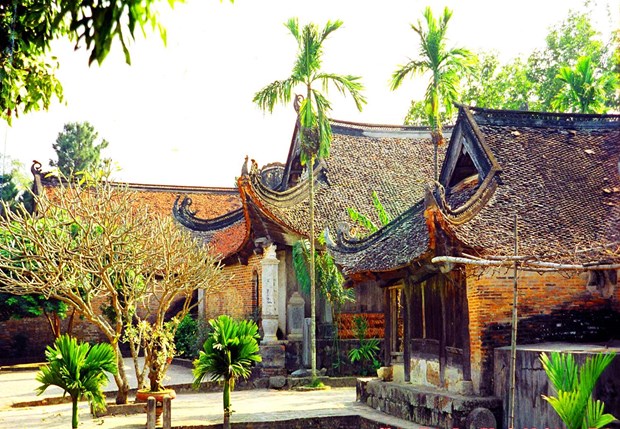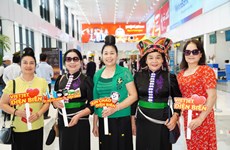Explore the land of Truc Lam Zen Buddhism
Taking a stroll in the ancient and peaceful Vinh Nghiem Pagoda, known as a centre for Buddhism in the northern province of Bac Giang, is a special experience that everyone should try.
 A corner of Vinh Nghiem pagoda in Bac Giang province (Photo: dangcongsan.vn)
A corner of Vinh Nghiem pagoda in Bac Giang province (Photo: dangcongsan.vn)Vinh Nghiem Pagoda was built in the Ly Dynasty in the 11th century under the reign of King Ly Thai To (1010-1028) in the village of Duc La, Tri Yen Commune, Yen Dung District, about 80km from Hanoi.
“Initially named Chuc Thanh, the pagoda later took the name of the village and was called La Pagoda or Duc La Pagoda,” said Le Thi Khoi, from the Relics Management Board of Yen Dung District.
“The pagoda was embellished, expanded, and renamed Vinh Nghiem under the reign of Tran Nhan Tong (1278-1293). Vinh Nghiem means Forever Lasting and Solemn,” Khoi added.
It was where the three first patriarchs of Truc Lam Zen Buddhism: Tran Nhan Tong (1258-1308), Phap Loa (1284-1330) and Huyen Quang (1254-1334) once preached and it served as a training institution for monks during the Tran Dynasty (13th-14th centuries).
The pagoda is considered the first Buddhism university of Vietnam, and the place of origin for Truc Lam Zen Buddhism, playing an important role in the history of Buddhism in Vietnam general and in the Tran Dynasty in particular.
Special woodblocks
Coming to Vinh Nghiem, you can’t help talking about the valuable woodblocks here.
The collection of 3,050 woodblocks with about 2,000 Han-Nom characters, most of which are Buddhist texts, sutras, the writings of the three first patriarchs and some by other master monks of Truc Lam Zen Buddhism. The pagoda also stores some texts on treatments with medicinal herbs and acupuncture.
According to the Venerable Thich Thanh Vinh, vice head of Vinh Nghiem Pagoda, the woodblocks here were made by artisans of the craft villages in Bac Giang and Bac Ninh provinces, and especially Hai Duong Province’s Lieu Trang Craft Village, which specialises in engraving woodblocks.
The majority of the blocks feature printing on both sides and have been engraved with Han and Nom characters in a mirror like fashion. The depth of the engravings is approximately 1-1.5mm, so the prints on do (poonah) paper are very clear.
“The size of the woodblock depends on the category of the sutra. The biggest block is over 100cm in length and 40-50cm in width. The smallest one is only 15x20cm.
“The woodblocks not only consist of the deep thoughts and values of Truc Lam Zen, but also serve as remarkable calligraphic and artistic items, and mark the development of the Vietnamese Nom ideographic script in different periods of time.
“These are also excellent works of art with unique, original and irreplaceable features. Through this collection, readers can discover plentiful information about many fields such as religion, language, literature, medicine and art,” he said.
On May 16, 2012, at a meeting of the Asia Pacific Regional Committee of UNESCO held in Bangkok, Thailand, the Buddhist Sutra Woodblocks of Truc Lam Zen at Vinh Nghiem Pagoda were on the lists of World Documentary Heritage as part of the Memory of the World Programme. Their acceptance was based on the three criteria of authenticity; uniqueness and irreplaceability; and their position and role in the region.
Veteran monk Thich Thanh Vinh, vice head of Vinh Nghiem Pagoda said: "The woodblocks are now in good condition although they have been kept at fairly simple facilities for many years.
"The blocks are checked by monks at the pagoda four times a year. Because both sides of the blocks are carved with characters, the checks should be made carefully," he added. "That’s why they have been well preserved despite harsh weather and war.”
Vinh Nghiem Pagoda was recognised as a national historical and cultural site in 1964. Its festival, which is held annually from the 12th to 14th day of the second lunar month, was also recognised as a national intangible cultural heritage site in 2013. Significantly, the pagoda was recognised as a special national relic in 2015.
Thanks to the recognition, the number of visitors coming to Vinh Nghiem Pagoda has increased rapidly, from 82,000 visits in 2013 to 144,000 in the first eight months of this year, according to the Relic Management Board of the province’s Yen Dung District.
Tourism potential
“Bac Giang Province is home to more than 101 national and special national relic sites like Vinh Nghiem Pagoda, the Hoang Hoa Tham Relic Site, and the Yen The uprising zone complex which includes 23 relics in the four districts of Yen The, Tan Yen, Viet Yen and Yen Dung,” said Nguyen Phuc Thuong, Vice Director of Bac Giang’s Department of Culture, Sport and Tourism.
“The province is also endowed with various scenic sites, notably Bo Da Pagoda, Suoi Mo and Dong Thong tourism areas, Cam Son Lake and the Khe Ro primitive forest.”
According to Thuong, Bac Giang is also one of the provinces that hold the greatest number of annual festivals. It is estimated that the province has about 540 traditional festivals, which are held in the first three lunar months of the year. Many of them feature the unique cultural identities of local ethnic minority groups.
In addition, a variety of its specialties have long been famous throughout the country, such as lychees grown in Luc Ngan District, the rice wine of Van Village, the ceramics of Tho Ha, the crispy rice crackers of Ke Village, rice noodles of Nam Dương Village, and bee honey from Son Dong Village.
“Realising our great potential for tourism, we have mapped out plans to maximally exploit and develop our tourism products, especially on spiritual culture, history and ecological relaxation,” said Thuong.
With the target of turning tourism into one of its important economic sectors, Bac Giang has exerted efforts in implementing a number of programmes and projects to expand the industry in the coming decades.
“Thanks to the efforts, the number of tourists coming to our province has increased considerably, from 160,000 visits in 2011 to nearly 410,000 in 2015,” said Le Anh Duong, Vice Chairman of the Bac Giang People’s Committee.
“The average rate of increase in the 2011-15 period was 23.4 percent. We plan to reach more than one million visits by 2020, with an average rate of increase of 25 percent in the period 2016-20,” Duong said.
"Cooperation among neighbouring provinces to develop tourism, especially spiritual tourism, was essential.
“It’s feasible for Bac Giang to cooperate with Hanoi and other provinces including Quang Ninh, Lang Son, Hai Duong, Hai Phong, Thai Nguyen and even HCM City to develop our own tourism products and promote attractive tours."-VNA











